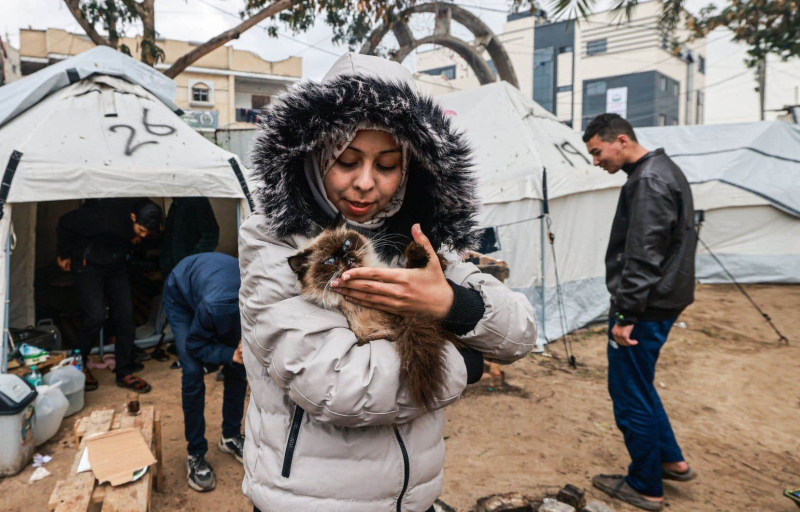
Photo: Mohammed Abed Agence France-Presse A young Palestinian woman holds a cat in her arms in a makeshift camp in Rafah, in the south of the Gaza Strip.
Adel Zaanoun – Agence France-Presse and Sharon Aronowicz – Agence France-Presse respectively in the Gaza Strip and Tel-Aviv
2:55 p.m.
- Middle East
Thousands of Palestinians continued to flee on foot or crowded on carts from the deadly fighting between the Israeli army and Hamas in the Gaza Strip on Friday, while the Qatari mediator reported signs with a view to a new truce.
The Health Ministry of the Palestinian Islamist movement Hamas reported 112 deaths in 24 hours across the Gaza Strip, besieged by Israel and largely destroyed after almost four months of war.
Israeli raids, according to witnesses, targeted the center and south of Gaza, especially Khan Younes, the second city in the Palestinian territory transformed into a field of ruins and now the epicenter of the battle.
In the rain, thousands of residents continued to flee areas of fighting, particularly Khan Younès, by car, on foot, by bicycle or on carts pulled by donkeys. Some people run as gunshots ring out and smoke rises nearby after an explosion, according to AFP images.
In this city, fighting rages around the two large hospitals, Nasser and al-Amal, which lack all basic equipment according to the Palestinian Red Crescent.
Also read
- Hamas would have reacted positively to a truce proposal, according to Qatar
- UNRWA controversy 'diverts attention' from humanitarian crisis in Gaza
- Political maneuvers in Israel amid negotiations for a truce in Gaza
More than 1.3 million of Gaza's approximately 2.4 million residents are now refugees in Rafah, a few kilometers south of Khan Yunis, trapped against the closed border with Egypt, threatened in the middle of winter by famine and epidemics, according to the UN.
The tents and plastic tarpaulins that have invaded the streets of Rafah are flooded by torrential rains.
“Death is more merciful than this life,” cries a Palestinian woman, her infant in her arms, in an artery crowded with displaced people.
“Despair Factory”
After calling the Gaza Strip “hell on earth,” the UN said Rafah had become a “factory of despair,” while UNICEF pointed out that at least 17 000 children are “unaccompanied or separated” from their families in this overcrowded territory of 362 km2.
The war was sparked by an unprecedented attack by Hamas commandos from the neighboring Gaza Strip on Israeli soil, which killed more than 1,160 people, mostly civilians, according to a AFP count based on official Israeli data.
A total of some 250 people were kidnapped and taken to Gaza on October 7, according to Israel; 132 hostages are still being held in Gaza, and among them 27 have been declared dead by the army.
In response, Israel vowed to “annihilate” Hamas, which took power in Gaza in 2007, and launched a military offensive that left 27,131 dead, the vast majority civilians. according to the Palestinian Movement's Ministry of Health.
While the war knows no respite, diplomacy attempts to impose a second truce, longer than that of a week which allowed at the end of November the release of a hundred Israeli hostages in exchange of Palestinians imprisoned by Israel.
Hamas leader Ismaïl Haniyeh, based in Qatar, is expected in Egypt to discuss a proposal drawn up during a recent meeting in Paris between CIA chief William Burns and Egyptian, Israeli and Qatari officials.
According to a Hamas source, the proposal concerns three phases, the first of which provides for a six-week truce during which Israel will have to release 200 to 300 Palestinian prisoners in exchange for 35 to 40 hostages held in Gaza, and 200 to 300 aid trucks will be able to enter the territory every day.
Diplomatic visits
This proposal was “approved by the Israeli side,” Qatari foreign ministry spokesperson Majed al-Ansari said on Thursday.
“We now have a first positive confirmation from Hamas,” he added, saying he hoped that “in the next two weeks we will be able to share some good news.”< /p>
But a source close to Hamas in Gaza denied this, telling AFP that Qatar's statement was “hasty and false.”
In this context of increased diplomatic efforts, the head of American diplomacy, Antony Blinken, is expected in the Middle East in the coming days. His French counterpart, Stéphane Séjourné, will go there from Saturday to Tuesday.
Israeli Prime Minister Benjamin Netanyahu is under strong pressure both from the families of hostages, who are demanding an agreement that would allow the release of their loved ones, and from several ministers who are threatening to leave the government .
Israel, which considers Hamas a terrorist organization, along with the United States, Canada and the European Union, continues to assert that it will only end its offensive in Gaza once the Islamist movement is eliminated , the hostages released and after having received guarantees on the future security of its territory.
The war in Gaza has also exacerbated tensions in the Middle East.
On Friday, Iranian President Ebrahim Raïssi warned that his country would respond “firmly” to any possible attack by the United States, which has threatened to retaliate for a strike blamed by Washington on a pro-group. Iran having killed three of their soldiers in Jordan on January 28.

